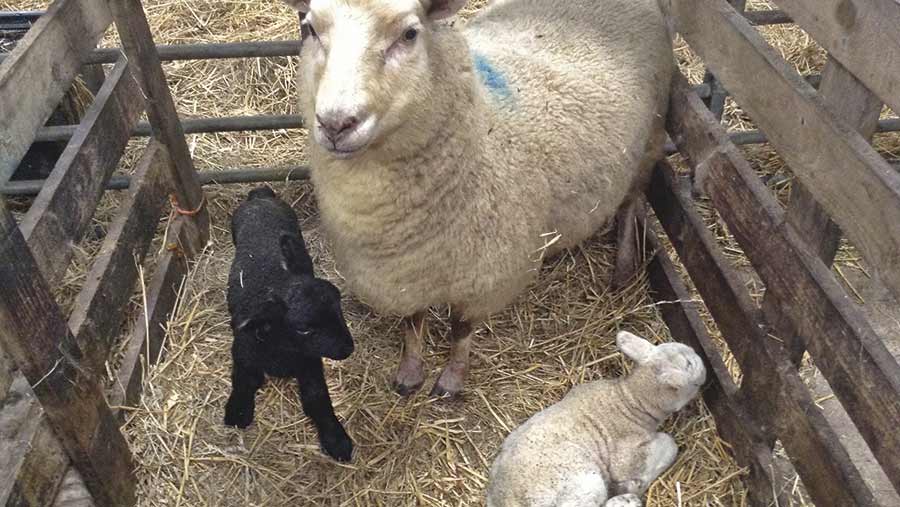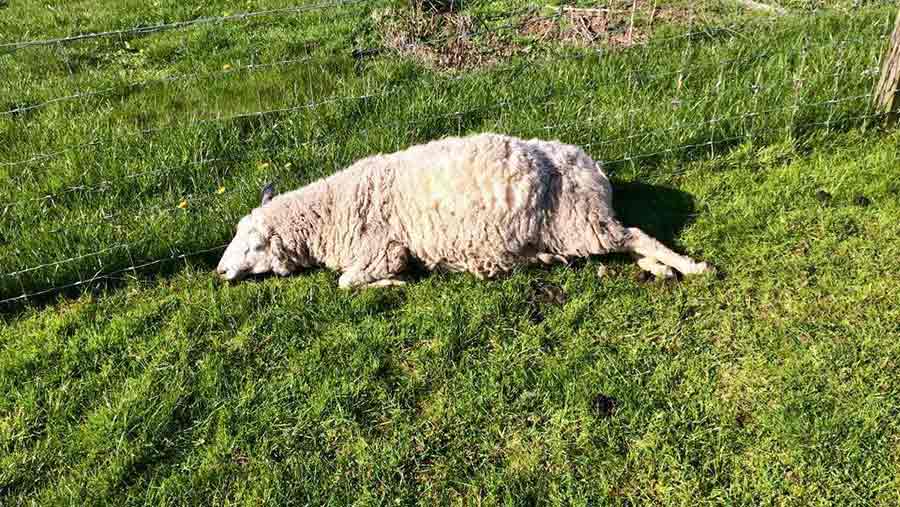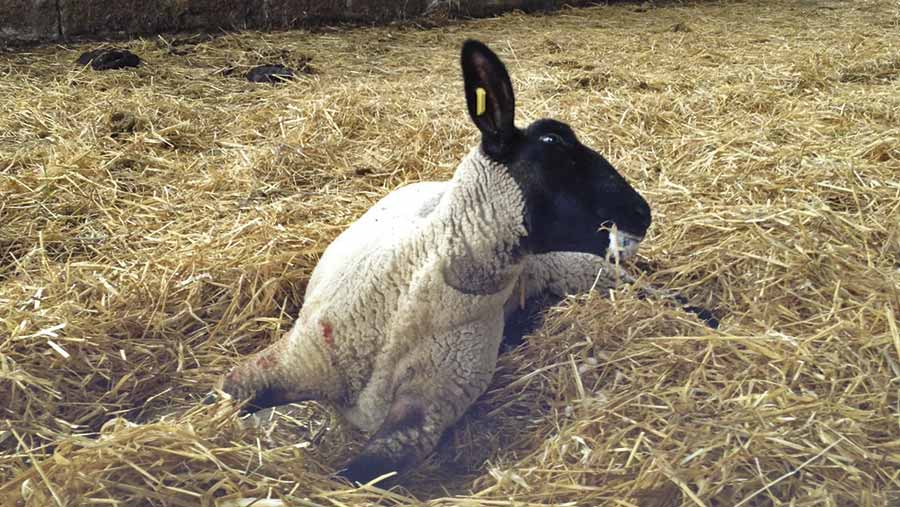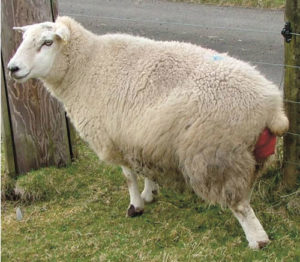7 key lambing diseases: How to prevent and treat them
Lamb and ewe losses are greatest around lambing time. By reducing these more lambs will be reared which can improve the bottom line for sheep farmers.
There are many different diseases that need to be recognised in lambs and ewes at this time and each farm will have their own problems to overcome.
Below, Westpoint vet Lesley Bingham from Launceston, Cornwall takes a look at some of the more commonly encountered ones and explains how to recognise them, what causes them and what to do about each condition.
Hypothermia
One of the most common problems in lambs is hypothermia. Lambs get cold very quickly unless they are well fed.
A lamb’s temperature should sit between 39-40C. Anything below this and the lamb has hypothermia. Temperatures less than 37C are classed as severe hypothermia.
Signs
- Lamb will be tucked up and lethargic and may not following their mother.
- If the hypothermia is severe the lamb may be flat and may not be able to hold up its head.
Treatment
Early action is essential as lambs will very quickly deteriorate and may die. How you approach a hypothermic lamb depends on three things – its temperature, age and ability to swallow.
- If hypothermia is mild (37-39C) – dry the lamb, feed and then warm.
- If hypothermia is severe (less than 37C) and the lamb is more than five-hours old and able to swallow – feed with stomach tube, dry and warm.
- If hypothermia is severe (less than 37C) and the lamb is more than five-hours old and unable to swallow – inject intraperitoneal glucose, dry and then warm.
- If the hypothermia is severe (less than 37C) and the lamb is less than five-hours old – dry and warm then feed with stomach tube.
It is vital lambs have a source of energy before any attempts are made to warm them up. This can be supplied either using a stomach tube to feed colostrum or if the lamb is unable to swallow then an injection of glucose directly into its peritoneal cavity.
The exception to this is lambs less than five hours old where they will have a supply of brown fat to provide a small amount of immediate energy.
However, it is still essential they are fed as soon as possible. If you are unsure of a lamb’s age then treat it as if it is over five hours and supply extra energy before warming it up.
Prevention
- Ensure lambs are well fed, top up any lambs with tube or bottle if needed.
- Provide extra shelter during harsh weather especially windy wet spells.
- Bring smaller lambs indoors if need be.
- Carry out extra checks when the weather is particularly bad to pick up problems as early as possible.
Watery mouth

This is caused by an E coli infection usually in the first few hours of life. It is influenced by two things: the amount of bacteria ingested and amount of colostrum consumed.
When a lamb is looking for the ewe’s udder it may take in bacteria from the ewe’s fleece or bedding. In older lambs, which have already had sufficient colostrum, the pH in the abomasum is lower and this kills off the bacteria.
If a lamb hasn’t has enough colostrum the bacteria multiply rapidly in the lamb’s gut and as the bacteria die they release a toxin.
Small amounts do no harm, but higher amounts will affect gut motility and this leads to further multiplication and toxin production.
If the amount of toxin produced is greater than the amount which the liver can destroy it will lead to endotoxemia, which is what causes the signs seen in watery mouth.
Signs
- Initially dull and depressed with a reluctance to feed.
- Collapse.
- Excessive salivation giving the condition its name.
- Gas in the gut can be heard (rattle belly).
- Sometimes scour is observed.
- Lambs will usually die within a few hours.
Treatment
Treatment of individual lambs can be successful, but relies on early identification and intervention.
- Supportive care to keep the lamb hydrated using electrolyte solution. Colostrum feeds should be avoided until gut distention has gone down.
- Use of antibiotics can be helpful although they will initially cause an increased release of toxins as the bacteria die.
- Enemas can help to simulate gut movement and remove some of the bacteria from the gut (20ml of warm soapy water into the rectum).
Prevention
The key to controlling watery mouth is preventing lambs ingesting large quantities of bacteria, and ensure that lambs have sufficient colostrum intakes.
- Lambs should get 50ml/kg colostrum in the first two hours and a total of 10% of its bodyweight in first 24 hours.
- Ensure ewes are in correct condition so they produce plenty of good-quality colostrum.
- Extra attention should be given to at risk lambs (multiples and those born to poorer ewes).
- Regular cleaning of lambing shed and using plenty of clean, dry bedding.
- Winter shearing or dagging to reduce contamination of the fleece.
Preventative oral antibiotics should only be used in consultation with your vet and not as an excuse for poor hygiene. They should be avoided at the start of lambing when they shouldn’t be needed at all and only used once problems start.
Joint/navel ill
An infection of the joints or navel, caused by many different types of bacteria but always related to hygiene in the first few days despite signs often coming weeks later.
Signs
- One or more swollen joints.
- Swollen, wet navel.
Treatment
- Injectable antibiotics are required.
- Antibiotic spray can also be used on navels.
- Severe cases may need a vet to drain and flush the infected area.
Prevention
- Good hygiene in the lambing areas is essential.
- When applying tail and castration rings ensure clean equipment and technique.
- Ensure navel is covered with strong iodine (10%) solution as soon as possible after birth and check at 24 hours and redip if necessary.
- Dip cups get better coverage compared to spraying but should be regularly cleaned and have the solution replaced.
- Ensure adequate intake of good-quality colostrum.
Twin lamb disease (pregnancy toxaemia)
This is a disease of ewes usually in very late pregnancy and results from insufficient energy intakes to meet the requirements of the growing unborn lambs.
Progression can be rapid and can result in brain damage or death. Hypocalcaemia can often also be present as well.
Signs
- Depression.
- Loss of appetite.
- Apparent blindness.
- Progressing to recumbency.
- Often ewes carrying multiple lambs and in poor condition initially.
Treatment
- Oral drench with propylene glycol as soon as possible – 50ml twice daily.
- Calcium 20% injected under the skin in case hypocalcaemia is also present.
- Palatable feeds (good hay and concentrates).
In severe cases – call vet, they will consider:
- Intravenous glucose injection.
- Induction of lambing.
Prevention
- Correct nutrition in last two months of pregnancy.
- Scanning and condition scoring so feeding can be tailored to ewe’s requirements.
Hypocalcaemia (milk fever)

© Laura MacGregor
This is caused by abnormally low levels of blood calcium often follows a period of stress such as gathering, bad weather or housing.
It may co-exist with twin lamb disease and due to the rapid progression and often fatal outcome, treatment of both diseases is usually sensible.
Signs
- Unsteady on their feet progressing to recumbency.
- Neck turned back, muscle weakness and tremors.
- Increased respiration rate.
- Bloat and regurgitation may be noted.
Treatment
Injection of calcium – 80ml injected under the skin). Response is rapid (minutes). Also see treatment for twin lamb disease.
Prevention
- Avoid stress in late pregnancy – so handle carefully when gathered and avoid carrying out too many procedures at the same time (for example, worming, vaccination, fluke).
- Ensure adequate food supply during late pregnancy.
Listeria

This is an infection caused by the bacteria Listeria monocytogenes which is found in soil environments. It is often associated with silage feeding as the bacteria multiply in the less acidic conditions.
Often outbreaks are seen two to three weeks after feeding off silage affecting less than 2% of the flock (but rarely up to 10%). The bacteria often gain entry through erupting teeth and track up the nerve to the brain.
Signs
- Younger ewes (18-24 months) most commonly affected due to erupting teeth.
- Lack of appetite.
- Depressed and disorientated.
- Food might be impacted in the cheek.
- Salivation.
- Facial paralysis results in lowered ear, dropping eyelid, flaccid lip and muzzle pulled over to side.
Treatment
- Antibiotic injections are sometimes successful – please consult your vet for best treatment.
- Even successful treatment takes time and the ewe will need supportive care such as soaked sugar beet to help eating.
- Administer propylene glycol to prevent energy deficit and twin lamb disease.
Prevention
- Discontinue use of the silage used approximately two weeks previously.
- Spoiled silage should be routinely discarded or fed to cattle which are less susceptible.
- Minimise soil contamination during silage making.
- Ensure punctured bales are repaired promptly and clamps are well rolled.
Vaginal prolapse

© Laura MacGregor
This is a protrusion of the vagina and occurs before lambing. Sometimes the prolapse will disappear once a ewe stands up.
Risk factors include overweight ewes, carrying triplets, limited exercise (lameness/recumbent).
Prolapse can go on to perforate allowing the ewe’s guts to protrude. They can cause abortion and also commonly cause incomplete cervical dilation (ringwomb).
Treatment
- Thoroughly wash and inspect for damage.
- Gently push prolapse back in using the palm of your hand.
- Use a spoon or harness to keep in place.
- Repeated cases/very large prolapse get a vet to replace under epidural injection and stitch in place.
Prevention
- Avoid allowing ewes getting overweight.
- Cull any ewes that have suffered a prolapse as it will repeatedly happen.
References/reading list
- Henderson DC (2002) Veterinary book for sheep farmers
- Hindson JC & Winter AC (2002) Manual of sheep diseases
- Nadis Ltd (2018) Nadis animal health skills
Vet advice
It should be noted there are other diseases that can occur and if you are unsure then you should consult your vet to confirm the diagnosis.
